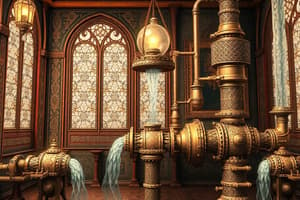Podcast
Questions and Answers
What does Bernoulli's theorem help to determine in fluid dynamics?
What does Bernoulli's theorem help to determine in fluid dynamics?
- The temperature of the fluid
- The density of the fluid
- The viscosity of the fluid
- The velocity and pressure of the fluid (correct)
Which of the following manometers is used to measure the pressure difference between two points in a fluid system?
Which of the following manometers is used to measure the pressure difference between two points in a fluid system?
- Inclined manometer
- Digital manometer
- Simple manometer
- Differential manometer (correct)
Which mixing method is NOT typically used for solids?
Which mixing method is NOT typically used for solids?
- Sigma blade mixer
- Twin shell blender
- Ribbon blender
- Venturi mixer (correct)
At what Reynolds number does flow typically transition from laminar to turbulent?
At what Reynolds number does flow typically transition from laminar to turbulent?
Which device can be used to measure both the flow rate and the velocity of a fluid?
Which device can be used to measure both the flow rate and the velocity of a fluid?
What does a simple manometer measure in a fluid system?
What does a simple manometer measure in a fluid system?
Which of the following blenders is specifically designed for solid mixing?
Which of the following blenders is specifically designed for solid mixing?
What condition characterizes laminar flow based on Reynolds number?
What condition characterizes laminar flow based on Reynolds number?
Which device is used in conjunction with flow meters to measure fluid flow?
Which device is used in conjunction with flow meters to measure fluid flow?
Which of the following factors does NOT affect mixing in fluids?
Which of the following factors does NOT affect mixing in fluids?
When the Reynolds number is between 2000 and 4000, the flow is identified as?
When the Reynolds number is between 2000 and 4000, the flow is identified as?
In Bernoulli's theorem, which of the following is NOT a term considered in energy conservation?
In Bernoulli's theorem, which of the following is NOT a term considered in energy conservation?
What is the purpose of an orifice meter in fluid dynamics?
What is the purpose of an orifice meter in fluid dynamics?
Which mixing mechanism is commonly used for emulsifying liquids?
Which mixing mechanism is commonly used for emulsifying liquids?
Flashcards are hidden until you start studying
Study Notes
Flow of Fluids
- Fluid flow is characterized by various types of manometers, including simple and differential manometers.
- Simple manometers measure pressure at a specific point within a contained fluid, expressed in terms of height difference called "HEAD."
- Differential manometers gauge the pressure difference between two points in a fluid system.
- Reynolds number (Re), critical in fluid dynamics, indicates the flow nature: Re < 2000 signifies laminar flow, Re > 4000 indicates turbulent flow, and 2000 < Re < 4000 suggests transitional flow.
Bernoulli’s Theorem
- Bernoulli’s theorem correlates pressure, velocity, and elevation in fluid dynamics and is a foundational principle for understanding flow behavior.
- Applications of Bernoulli's theorem include oraifice meters and venturi meters, designed for fluid flow measurement.
Energy Losses in Fluids
- Energy losses in a fluid system occur due to friction, turbulence, and obstructions, influencing overall efficiency.
Fluid Measurement Instruments
- Orifice meter: Measures flow rate by creating a differential pressure.
- Venturi meter: Utilizes converging and diverging sections to measure fluid velocity and flow.
- Pitot tube: Measures fluid velocity based on pressure differences.
- Rotameter: Measures the flow rate of liquids and gases through a tapered tube.
Mixing Processes
- Mixing aims to achieve uniformity in ingredient distribution and is essential in chemical engineering.
- Key factors influencing mixing include viscosity, density, and particle size.
- Solid vs. Liquid Mixing: Solid mixing revolves around mechanics like diffusion, while liquid mixing may involve shear forces.
- Types of Mixers:
- Double cone blender: Effective for bulk solid blending.
- Twin shell blender: Used for dry blending of powders.
- Ribbon blender: Features a helical ribbon for gentle mixing of powders.
- Sigma blade mixer: Often used for viscous pastes and doughs.
- Planetary mixers: Excellent for heavy mixtures; the stirring blades rotate on an axis while orbiting the bowl.
- Propellers, turbines, paddles: Different types of impellers used for liquid mixing.
- Silverson emulsifier: Known for emulsifying and homogenizing liquids.
Learning Outcomes
- Acquire a comprehensive understanding of fluid mechanics principles, including fluid behavior and mixing technologies.
Flow of Fluids
- Fluid flow is characterized by various types of manometers, including simple and differential manometers.
- Simple manometers measure pressure at a specific point within a contained fluid, expressed in terms of height difference called "HEAD."
- Differential manometers gauge the pressure difference between two points in a fluid system.
- Reynolds number (Re), critical in fluid dynamics, indicates the flow nature: Re < 2000 signifies laminar flow, Re > 4000 indicates turbulent flow, and 2000 < Re < 4000 suggests transitional flow.
Bernoulli’s Theorem
- Bernoulli’s theorem correlates pressure, velocity, and elevation in fluid dynamics and is a foundational principle for understanding flow behavior.
- Applications of Bernoulli's theorem include oraifice meters and venturi meters, designed for fluid flow measurement.
Energy Losses in Fluids
- Energy losses in a fluid system occur due to friction, turbulence, and obstructions, influencing overall efficiency.
Fluid Measurement Instruments
- Orifice meter: Measures flow rate by creating a differential pressure.
- Venturi meter: Utilizes converging and diverging sections to measure fluid velocity and flow.
- Pitot tube: Measures fluid velocity based on pressure differences.
- Rotameter: Measures the flow rate of liquids and gases through a tapered tube.
Mixing Processes
- Mixing aims to achieve uniformity in ingredient distribution and is essential in chemical engineering.
- Key factors influencing mixing include viscosity, density, and particle size.
- Solid vs. Liquid Mixing: Solid mixing revolves around mechanics like diffusion, while liquid mixing may involve shear forces.
- Types of Mixers:
- Double cone blender: Effective for bulk solid blending.
- Twin shell blender: Used for dry blending of powders.
- Ribbon blender: Features a helical ribbon for gentle mixing of powders.
- Sigma blade mixer: Often used for viscous pastes and doughs.
- Planetary mixers: Excellent for heavy mixtures; the stirring blades rotate on an axis while orbiting the bowl.
- Propellers, turbines, paddles: Different types of impellers used for liquid mixing.
- Silverson emulsifier: Known for emulsifying and homogenizing liquids.
Learning Outcomes
- Acquire a comprehensive understanding of fluid mechanics principles, including fluid behavior and mixing technologies.
Studying That Suits You
Use AI to generate personalized quizzes and flashcards to suit your learning preferences.




